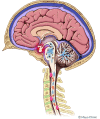Erdheim-Chester Disease
- PMID: 36997288
- PMCID: PMC10171379
- DOI: 10.3174/ajnr.A7832
Erdheim-Chester Disease
Abstract
Erdheim-Chester disease is a rare non-Langerhans cell histiocytosis. The disease is widely variable in its severity, ranging from incidental findings in asymptomatic patients to a fatal multisystem illness. CNS involvement occurs in up to one-half of patients, most often leading to diabetes insipidus and cerebellar dysfunction. Imaging findings in neurologic Erdheim-Chester disease are often nonspecific, and the disease is commonly mistaken for close mimickers. Nevertheless, there are many imaging manifestations of Erdheim-Chester disease that are highly suggestive of the disease, which an astute radiologist could use to accurately indicate this diagnosis. This article discusses the imaging appearance, histologic features, clinical manifestations, and management of Erdheim-Chester disease.
© 2023 by American Journal of Neuroradiology.
Figures




References
MeSH terms
LinkOut - more resources
Full Text Sources
